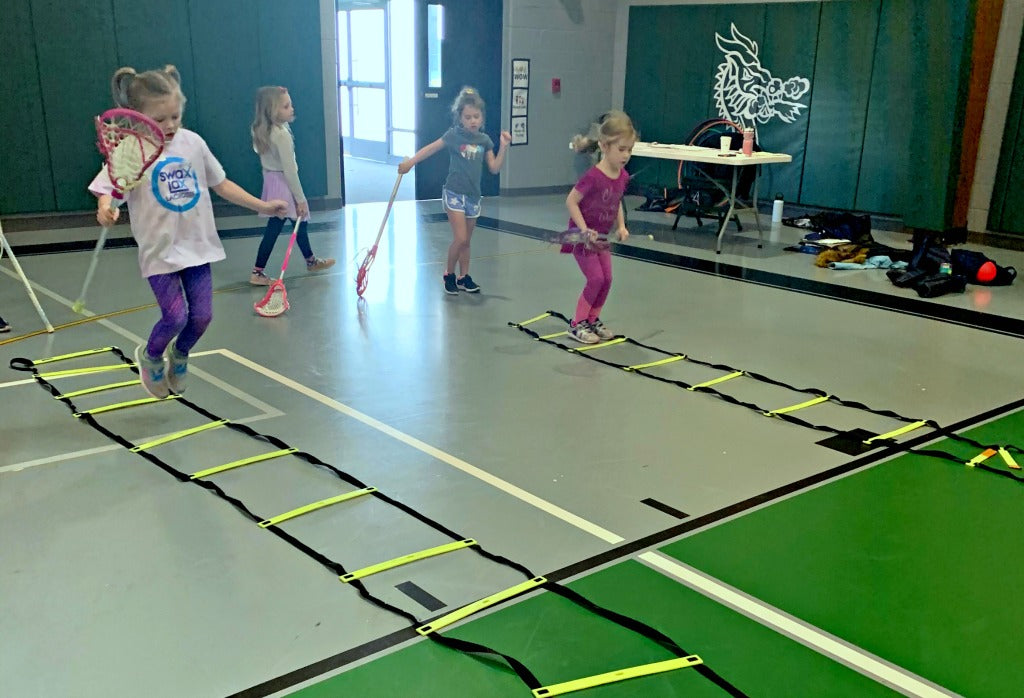Dynamic Drills for the Youngest Lacrosse Players

Looking for lacrosse drills to run with younger players whether indoors or out? All four of these drills work well for players as young as five, and can be tweaked for a higher degree of difficulty for middle school beginners. So long as coaches take the time to explain the key teaching points involved in each skill at the start, the players will have a ball once the drills get going.
Four Skills Stations
- What Time Is It Mr. Fox?
- Sleeping Giant
- Worst Pass Ever Drill
- Give-and-Go Ladder Drill
What Time Is It, Mr. Fox? Lacrosse Drill
Teaches cradling on the run
Equipment: Swax Lax balls, little stickers
Purpose
- Keep the ball in the stick while running.
- There is no “one size fits all” cradle.
- Stick in the “triple threat” position with the top hand ¾ of the way up the shaft and the bottom hand anchored at the bottom of the stick: shoulder, shoulder, stick.
- Arms up and away from the body, as if you were making a muscle.
- Keep stick in protected zone away from defender.
- Eyes up to be ready to pass, shoot, or run.
Cradling Tip: Teach your player how to properly cradle with the “Hi and Bye” drill. Simply have players say “Hi” and “Bye” to their stick and ball by going shoulder to shoulder.
Drill
- Each player has a ball in her stick, lined up horizontally facing the coach.
- Coach is the fox who turns her back away from players to start.
- Girls in unison yell, “What time is it, Mr. Fox?” Coach shouts back any number between 1:00 and 11:00.
- Whatever time is yelled, the players take the requisite paces, cradling on the move.
- Finally, as the players are close to approaching the coach, the coach yells back the time “Midnight!” whereupon the coach chases the girls back to the line attempting to catch a few.
- Players who are caught join the coach’s side and become foxes.
Sleeping Giant Lacrosse Drill
Teaches scooping and cradling on the run
Equipment: Swax Lax balls, whistle
Purpose
To practice ground ball motion on the move
- Put front foot beside the ball.
- Top hand is near the top of the stickhead.
- Put head down and get low.
- Scoop hard like you’re shoveling snow.
- Knuckles to the ground.
- Big step as you are picking up the ball.
- Begin cradling as soon as it’s in the stick to protect the ball.
- Box out your opponent by running straight downfield rather than on a diagonal to minimize the chances your opponent can catch you.
Scooping Tip: Before playing Sleeping Giant, teach the five-yard scoop drill. Have players line up horizontally. Place a ball five yards in front of each player. On whistle, players run up and prepare to scoop. On the second whistle, the players freeze. (Coach should check their form and make adjustments.) On third whistle, players scoop up the ball and run to the other side of the gym or field.
Drill
- Coaches, who are the “giants,” sprinkle all the balls (the giants’ food) around themselves in the center of the gym or field, and then they pretend to go to sleep.
- Meanwhile, the players are allowed to tip-toe up to the giants and one-by-one, scoop up a piece of food and cradle it back behind their starting line (lair).
- Soon the giants hear the commotion and make a big show of roaring their displeasure and begin chasing the food stealers. Anyone who is caught, joins the giants’ family as a baby giant.
Worst Pass Ever Lacrosse Drill
Equipment: Two coaches, lots of Swax Lax balls
Purpose
To learn to move your feet to ball, catching no matter where the pass might go
Note: Explain that as coaches, you will be cutting to the ball and catching on the run to avoid the imaginary defender. You can designate opposing team members to be real defenders.
Drill
- Explain that at least half the passes in lacrosse, especially at the youth level, are “bad passes.” Yet players must work hard to catch every ball that comes their way.
- Divide players into two or three teams.
- Players line up in their teams with a respective coach at least 20 yards away.
- Players take turns passing to their coaches and then rotate to the back of the line.
- Coach cuts for the ball and tries his hardest to catch every ball thrown.
- The team whose coach catches the most balls wins.
This is a good team competition that enables the players to practice their throws without fear of making a bad pass. You may add on to this drill by having players be the one to catch the ball. For an extension of this drill, watch Catching at All Angles Drill.
Give and Go Ladder Lacrosse Drill
Equipment: Ladder, Swax Lax balls, two coaches, goal
Purpose:
To practice agility and speed while protecting the stick during cradling and then learn how to execute a (modified) give and go followed by a shot.
Drill:
Progression 1:
Players practice running through the ladder while cradling. Eyes up if possible. One foot in each box.
Progression 2:
Coaches hold out their sticks into the path of the ladder so players must switch hands or pull stick to the other side of the body for more protection.
Progression 3:
As players come through the ladder, they should keep eyes and elbows up and pass to coach at the restraining line, who will then toss it back underhand. Encourage players to keep their feet moving the whole time.
Progression 4:
Add a shot.
The best part of these drills is that they each establish confidence while adding a little fun and competition to the mix. You can make the drills more challenging or modify them for younger players by adding or waiting to add a ball to the player’s stick, or even using a handball.
Give these drills a try with your players and tag us at @swaxlaxball or @swaxlaxlacrosse. We can’t wait to see what you do.




